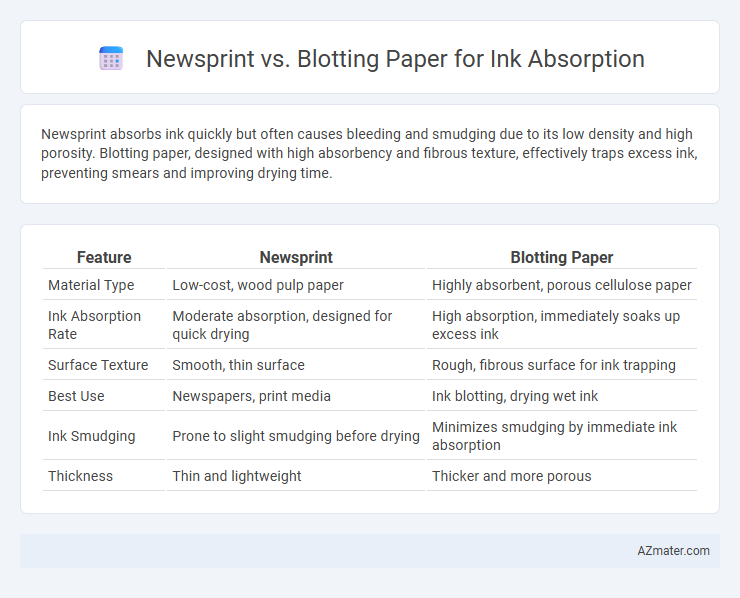Newsprint absorbs ink quickly but often causes bleeding and smudging due to its low density and high porosity. Blotting paper, designed with high absorbency and fibrous texture, effectively traps excess ink, preventing smears and improving drying time.
Table of Comparison
| Feature | Newsprint | Blotting Paper |
|---|---|---|
| Material Type | Low-cost, wood pulp paper | Highly absorbent, porous cellulose paper |
| Ink Absorption Rate | Moderate absorption, designed for quick drying | High absorption, immediately soaks up excess ink |
| Surface Texture | Smooth, thin surface | Rough, fibrous surface for ink trapping |
| Best Use | Newspapers, print media | Ink blotting, drying wet ink |
| Ink Smudging | Prone to slight smudging before drying | Minimizes smudging by immediate ink absorption |
| Thickness | Thin and lightweight | Thicker and more porous |
Introduction to Ink Absorption Properties
Newsprint is a low-cost, highly porous paper designed for rapid ink absorption, which makes it ideal for printing newspapers where fast drying is essential. Blotting paper has a dense, fibrous structure that absorbs excess ink quickly, preventing smudging and ensuring clean, crisp writing or drawing. The contrasting ink absorption rates are determined by the paper's fiber density and surface texture, with newsprint favoring fast ink spread and blotting paper prioritizing swift ink removal.
What is Newsprint?
Newsprint is a low-cost, non-archival paper primarily used for printing newspapers, characterized by its lightweight, porous texture that allows for rapid ink absorption. It absorbs ink quickly but tends to cause some bleeding and feathering due to its high porosity and rough surface. Unlike blotting paper, which is specifically designed to absorb excess ink without spreading, newsprint prioritizes fast drying for mass printing applications.
What is Blotting Paper?
Blotting paper is a highly absorbent paper designed specifically to soak up excess ink from writing surfaces, preventing smudging and promoting faster drying times. Unlike newsprint, blotting paper has a porous structure that quickly draws ink away from the paper surface, making it ideal for use with fountain pens and calligraphy. This specialized paper is often made from cotton or wood pulp fibers, offering superior ink absorption compared to the coarser, less absorbent newsprint typically used for printing newspapers.
Composition and Structure Differences
Newsprint is composed primarily of low-cost wood pulp with minimal processing, resulting in a porous, lightweight structure that absorbs ink rapidly but with less precision. Blotting paper, made from highly compressed cotton or linen fibers, features a dense, fibrous network designed specifically to absorb excess ink efficiently without spreading. The contrasting fiber density and refinement in their compositions directly influence their ink absorption rates and suitability for different writing and printing applications.
How Ink Spreads on Newsprint
Newsprint absorbs ink quickly due to its high porosity and coarse fiber structure, causing ink to spread and feather on the surface. This rapid absorption results in less precise lines and a more diffused appearance compared to blotting paper, which evenly soaks up excess ink, minimizing spread. Understanding the absorption qualities of newsprint is essential for artists and printers seeking to control ink flow and detail sharpness.
Ink Absorption Efficiency of Blotting Paper
Blotting paper exhibits superior ink absorption efficiency compared to newsprint due to its porous and fibrous structure, specifically designed to rapidly wick and hold excess ink without smudging. This high absorbency reduces drying time, making blotting paper ideal for calligraphy, fountain pens, and ink drying processes. Newsprint, though porous, lacks the specialized fibers and density control of blotting paper, resulting in slower absorption and increased ink spread.
Comparing Drying Speeds: Newsprint vs Blotting Paper
Newsprint absorbs ink quickly but allows moderate drying speed due to its porous, low-cost fibers designed for rapid print production. Blotting paper excels in absorbing excess ink instantly, resulting in the fastest drying times by preventing smudging and spreading on writing surfaces. The key distinction lies in blotting paper's superior capillary action and higher absorbency, making it ideal for situations requiring immediate ink drying compared to newsprint's slower drying profile.
Cost and Availability Considerations
Newsprint offers a cost-effective solution with wide availability, making it ideal for high-volume ink absorption needs despite its lower quality and faster ink bleed compared to blotting paper. Blotting paper, although pricier and less readily available, excels in superior ink absorption and precision, suitable for specialized uses such as calligraphy or archival purposes. Choosing between the two depends on budget constraints and the specific requirements for ink control and paper performance.
Best Uses for Each Paper Type
Newsprint excels in quick ink absorption, making it ideal for mass-produced newspapers and print media where rapid drying is essential. Blotting paper offers superior ink absorption without smudging, perfect for calligraphy, fountain pen use, and preserving delicate documents. Each paper type serves distinct ink-related needs: newsprint for speed and cost-efficiency, blotting paper for precision and quality ink management.
Conclusion: Choosing the Right Paper for Ink Absorption
Newsprint absorbs ink quickly but lacks precision, making it ideal for fast drying in newspapers yet unsuitable for detailed artwork. Blotting paper excels in absorbing excess ink efficiently, preventing smudges and ensuring cleaner prints, especially for calligraphy or fountain pen use. Selecting the right paper depends on the balance between ink absorption speed and the need for sharpness, with blotting paper preferred for precision and newsprint for volume and speed.

Infographic: Newsprint vs Blotting Paper for Ink Absorption
 azmater.com
azmater.com